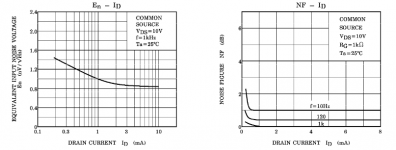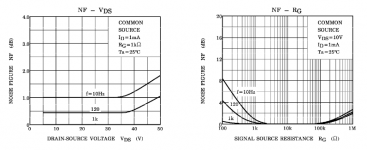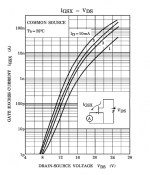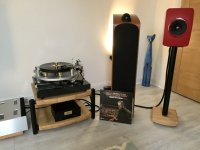If you've got JFETs, or if you can get JFETs, use them! They are obsolete and they are disappearing fast. Buy em now and use em now, the window is closing.
Later, if you feel like it, you can build a BJT circuit to do the same function, and compare the two. But do the JFET version first, and do it right away. If you sit around in Analysis Paralysis, thinking and worrying rather than building, you'll find it harder and harder to obtain the devices.
Later, if you feel like it, you can build a BJT circuit to do the same function, and compare the two. But do the JFET version first, and do it right away. If you sit around in Analysis Paralysis, thinking and worrying rather than building, you'll find it harder and harder to obtain the devices.
Is there any solid proof that a real world moving magnet cartridge behaves better with a fet input than with a BJT input?
Yes. Vogel, The Sound of Silence, Springer Verlag.
I have them all, built fet preamps, listened used or mod commercial fet preaps of all qualities , but they don't even come close to a good valve preamp while some bjt phono preamps just blew me away with their results for their cost and simplicity and overall sound was always better with BJT than fet in my experience...That is all i can say from my part.
I saw its first edition a long time ago .Yes. Vogel, The Sound of Silence, Springer Verlag.
There's a problem with the real world measurements oposed to that utterly convincing theoretical exhibition.I have a feeling that the guy never tried to use a 2sk170 at 10ma supplied at 7.5v DC.I did that and experienced some of the most noisy transistor circuit i ever heard! Actually 2sk170 works best at 4...5v DC DS and about 0.5...2ma
You might be right, i used the GR version, didn't have the BL or V one, but the minimum noise for 2sk170 is defined at 1ma in the datasheet .It may be like that just to include the GR specs....I did also try 2sk369BL too which is almost the same noise at 5x higher current(5ma)
Last edited:
I don't see anything in the Toshiba 2SK170 datasheet that implies that a 1 mA drain current would result in minimal noise. The equivalent input noise of a JFET usually drops with increasing current as long as the gate-source junction doesn't go in forward conduction and as long as the drain-source voltage is not so high that you get excessive gate leakage due to impact ionization. The plots in the datasheet seem to be consistent with that. I guess that 1 mA is just a current that lies comfortably below the 2.6 mA minimum IDSS, but is still high enough to get reasonably close to the minimal equivalent input noise voltage density.
Attachments
I saw its first edition a long time ago .
There's a problem with the real world measurements oposed to that utterly convincing theoretical exhibition.I have a feeling that the guy never tried to use a 2sk170 at 10ma supplied at 7.5v DC.I did that and experienced some of the most noisy transistor circuit i ever heard! Actually 2sk170 works best at 4...5v DC DS and about 0.5...2ma
You should not teach me about real world measurements. I designed and built enough of JFET line stages including MM preamps and my main MM preamp uses quad JFET input.
http://pmacura.cz/phono_modul.jpg
Once, about 10 years ago, I purchased a batch of "2SK170/2SJ74" from a Hong-Kong supplier, and they were all fakes. And they created "one of the most noisy transistor circuits", as you are saying.
If you've got JFETs, or if you can get JFETs, use them! They are obsolete and they are disappearing fast. Buy em now and use em now, the window is closing.
CPH5902, CPH59905 have a noise figure of 1 with an NPN in the package. NSVJ5908DSG5 is a dual with NF 1dB.
Interfet IF3601, IF3602 are very expensive, long lead times.
You need to know the conditions to interpret noise figures, a JFET with a noise figure of 1 dB at 1 Mohm source resistance would still be quite bad. Looking up the datasheets:
CPH5902, CPH5905 and NSVJ5908DSG5: 1 dB at 1 kHz, 1 kohm, 1 mA, so 2.0364 nV/sqrt(Hz) at 1 kHz, 1 mA.
IF3601, IF3602: 0.5 nV/sqrt(Hz) at 100 Hz, 5 mA.
All very well suited for moving-magnet amplifiers, although the Ciss of 300 pF typical and Crss of 200 pF typical of the IF3601 and IF3602 could be problematic; depending on the circuit, the load capacitance that the cartridge sees could easily become too large.
CPH5902, CPH5905 and NSVJ5908DSG5: 1 dB at 1 kHz, 1 kohm, 1 mA, so 2.0364 nV/sqrt(Hz) at 1 kHz, 1 mA.
IF3601, IF3602: 0.5 nV/sqrt(Hz) at 100 Hz, 5 mA.
All very well suited for moving-magnet amplifiers, although the Ciss of 300 pF typical and Crss of 200 pF typical of the IF3601 and IF3602 could be problematic; depending on the circuit, the load capacitance that the cartridge sees could easily become too large.
The LSK389’s are available and they can make a very low noise MM stage - as close to the theoretical limit as is possible. The biggest noise source in any MM stage is the cartridge L and R shunting the 47k load resistor.
I have a stash of 1000 BF862’s which were (other then the Interfets’s) the lowest noise JFET’s available for many years - sadly discontinued now.
I have a stash of 1000 BF862’s which were (other then the Interfets’s) the lowest noise JFET’s available for many years - sadly discontinued now.
Last edited:
With A- and RIAA-weighting, the thermal noise of the 47 kohm resistor is usually of the same order as that of the cartridge resistance (including its increase over frequency due to iron losses), and when there is a record playing, both are usually much smaller than the record surface noise. You can largely get rid of the 47 kohm resistor noise by electronic cooling/synthesized loading/combinations of series and shunt feedback/whatever you want to call it.
Agree on the electronic cooling Marcel - excellent idea.
Sy has a very nice spread sheet based on the Natsemi noise app note that calculates the noise contribution of the cart + load combo.
Discrete JFET input stages don’t suffer from the current noise contribution you get with bip input stages (but you know that of course!) so for SOTA phono preamps I think you have to go for JFET. That said, for c. $ 40c a NE5534A is still a remarkable bargain and will get you to within c. 3 dB of a good discrete phono stage. Talking of which, just listening to a vinyl right now
Sy has a very nice spread sheet based on the Natsemi noise app note that calculates the noise contribution of the cart + load combo.
Discrete JFET input stages don’t suffer from the current noise contribution you get with bip input stages (but you know that of course!) so for SOTA phono preamps I think you have to go for JFET. That said, for c. $ 40c a NE5534A is still a remarkable bargain and will get you to within c. 3 dB of a good discrete phono stage. Talking of which, just listening to a vinyl right now
Attachments
Last edited:
You should not teach me about real world measurements. I designed and built enough of JFET line stages including MM preamps and my main MM preamp uses quad JFET input.
http://pmacura.cz/phono_modul.jpg
Once, about 10 years ago, I purchased a batch of "2SK170/2SJ74" from a Hong-Kong supplier, and they were all fakes. And they created "one of the most noisy transistor circuits", as you are saying.
I started with a rethorical question in this topic yet a question and i don't need to believe in Anyone's name!
I don't teach anyone anything, i only tell my experiences which so far made me come in utter disbelief in j-fet miracles over the low noise bipolar transistors in audio preamplifiers.I also tried 2sk369BL sourced from very good cassette players in the same circuits and the noise was the same...higher than the bipolar version i wanted to improve.Some of my experiences in 2018 were described here:
Modified aiwa riaa j-fet phono preamp.
As for cassette players mods i came to the same concusion, bipolar input is lower noise that j-fet transistor.You can believe whatever you want.I trust myself more than anyone else and to this day it proved right to do so. MM cartridges are about 2...4 times higher Z than a tape head yet they provide 5...10 times higher signal than any tape head ever produced .All the professional tape-head playback preamps from Studer, Ampex, Otari, Teac are bipolar input not fet input! As vinyl preamps were never a studio format no recording equipment manufaturer invested in making the best solid state phono preamp , but the only standard that ever existed in Vinyl playback is EMT JPA-66 which is Valve input and that indicates that valves which theoretically are much higher noise input than fet transistors are good enough! Truth is that there are some valves that exceed overall j-fet performances with mm cartridge so again nothing to bother with.
What i really find annoying is to read tons of topics from DIY "guru " full of advices on fet preamps when Studer and Ampex industry standard was a bipolar input transistor transconductance stage.
My simple opinion is that Fet transistors were chosen for their convenience over the bipolar transistors , not for their very performance, and also due to a trend that started in the 70's when some other guru that needed to sell expensive equipment and share a fine life along their wealthy clients start talking about what horrible things a capacitor coupled input would do to the sound...Ask Studer and Ampex first about that!
Truth is that a capacitor input is ideal for coupling a phono input as you naturally escape a lot of the pressure, put by infrasonic vibrations. Unfortunately most people go with the JC opinion on capacitor distortions which were never proved scientifically and will never be, but sold millions of overly expensive useless equipment. MM cartridge input is higher impedance than a microphone maybe, but not that high to need any fet input.
I promiss i;ll make one more try one day with 2sk170BL and 2sj74 sourced from a scrapped maratz cd 63.If they are better than my low noise bipolar in mm preamps i will come back with an honest report.I also have some bf862, but never used them...
Last edited:
ksc1815 or 1845? 85db s/n is 1 db over dolby s which is already dead silent...
I always remember a guy round here pretending to have been part of the Studer engineering team who said that he could hear sounds 110db into the tape noise and the only thing i could figure about that it was that he got a role in Poltergeist . Unfortunately Ray Dolby missed that casting because he wasn't able to hear anything less than -84db There is also a 70 years old engineer on another audio site pretending he can hear more into the tape hiss with a j-fet nakamichi type of playback while Tandberg 3014 was equally worshiped in Europe and it was made with bipolar input.Actually European companies preffered bipolar transistors in their low noise equipment while japanese and american manufactureres went with the fancy j-fet input while claiming all sort of things due to no capacitor coupling down to DC BLA BLA...
There is also a 70 years old engineer on another audio site pretending he can hear more into the tape hiss with a j-fet nakamichi type of playback while Tandberg 3014 was equally worshiped in Europe and it was made with bipolar input.Actually European companies preffered bipolar transistors in their low noise equipment while japanese and american manufactureres went with the fancy j-fet input while claiming all sort of things due to no capacitor coupling down to DC BLA BLA...
I always remember a guy round here pretending to have been part of the Studer engineering team who said that he could hear sounds 110db into the tape noise and the only thing i could figure about that it was that he got a role in Poltergeist . Unfortunately Ray Dolby missed that casting because he wasn't able to hear anything less than -84db
Last edited:
Regarding noise in an amplifier for moving-magnet cartridges, a high-transconductance JFET can easily outperform a properly optimized bipolar input stage, but there are two things to keep in mind:
1. The performance of a properly optimized bipolar input stage can be perfectly adequate. For example, suppose you decide not to use electronic cooling and have a cartridge with an inductance of about 500 mH. Looking at the total RIAA- and A-weighted noise, the thermal noise of the 47 kohm termination resistor will then dominate over that of a properly optimized bipolar input stage or a high-transconductance JFET input stage. Hence, you won't notice much difference between bipolar and JFET.
Of course the differences get even smaller (usually much smaller) when you put on a record.
2. The noise of amplifiers for moving-magnet cartridges is more often than not measured with a way too low source impedance: 0 ohm or 600 ohm, for example, instead of 600 ohm plus 500 mH. This reduces the effect of the amplifier's equivalent input noise current and makes amplifiers with incorrectly designed bipolar input stages (way too high collector currents) look good.
By the way, the mathematics behind these statements can be found in Electronics World October 2003 and in Linear Audio volume 8.
1. The performance of a properly optimized bipolar input stage can be perfectly adequate. For example, suppose you decide not to use electronic cooling and have a cartridge with an inductance of about 500 mH. Looking at the total RIAA- and A-weighted noise, the thermal noise of the 47 kohm termination resistor will then dominate over that of a properly optimized bipolar input stage or a high-transconductance JFET input stage. Hence, you won't notice much difference between bipolar and JFET.
Of course the differences get even smaller (usually much smaller) when you put on a record.
2. The noise of amplifiers for moving-magnet cartridges is more often than not measured with a way too low source impedance: 0 ohm or 600 ohm, for example, instead of 600 ohm plus 500 mH. This reduces the effect of the amplifier's equivalent input noise current and makes amplifiers with incorrectly designed bipolar input stages (way too high collector currents) look good.
By the way, the mathematics behind these statements can be found in Electronics World October 2003 and in Linear Audio volume 8.
- Status
- Not open for further replies.
- Home
- Source & Line
- Analogue Source
- FET vs BJT input phono preamp



